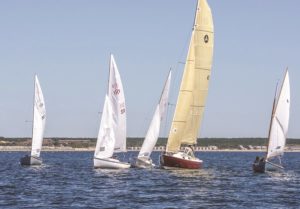PROVINCETOWN — There may be some tacking duels in Provincetown Harbor this summer. That’s when two or more sailboats are moving side to side, jostling for position toward the end of a race. Tacking duels, as well as other sailing maneuvers, are nothing out of the ordinary in the Provincetown Yacht Club’s summer racing series.
After a down year in 2020, there will be a full season of Saturday races beginning June 26 at 1 p.m. and running through Sept. 11. The course in the harbor ranges from 2 to 12 miles, depending on wind conditions.
Racers are usually club members or friends of members who have been invited to enter a boat in a race. The two classes of boats are dinghies (under 20 feet) and keel boats (over 20 feet).

“We have a combination of pretty experienced racers and others who are just beginners,” said Jack Peak, the club’s vice commodore. He and a buddy started the series 8 or 10 years ago, he said.
Ray Tobias, who summers in Provincetown, has been sailing for more than 60 years. He joined the Yacht Club six years ago because of the races.
“It’s great fun,” he said. “I’ve personally raced international races, regional races, and club races. This town has a great sailing history and it’s just a pleasure. The harbor is ideal.”
Each boat has to have a handicap number. Performance Handicap Racing Fleet New England is an independent authority that gives fleets numbers based on the kind of boat. All boats entered in the Provincetown racing series must be approved by the Yacht Club Race Committee.
A really fast sailboat will have a low handicap; a slower sailboat will have a higher one. The skipper of the faster boat has less time to finish the race than the skipper of the slower boat. The amount of time allotted varies, depending on the specifications of the boat.
“It gives people a chance to win a race that don’t have a fast boat,” said Peak.
So, a boat with a low handicap could finish first but still lose if a boat with a higher handicap finishes within a certain amount of time behind it. The handicap system puts all boats on a relatively even playing field. Races come down to which skipper makes the fewest mistakes and runs the cleanest race.
Peak said he expects eight to 10 boats on the water for each race this season. It can get competitive.
“The caliber of racing here is good,” said Tobias.
A few things have to happen before a race begins. An on-the-water race committee figures out the best course for the day, based on wind conditions. The first leg of the course, Tobias said, is always upwind. The committee determines a starting line that’s perpendicular to the wind.
There are permanent markers in the water that indicate where sailboats can travel, but the race committee may add markers based on the course for that day.
A warning flag is raised five minutes before the race, when the sailboats are aligned at the start. A second preparatory flag is raised four minutes before the race. Then, both flags are dropped just one minute before the race.
“The boats are jockeying for position at this point,” Tobias said. “The idea is to be at the starting line. You don’t want to be over the line before the start, because if you are, then you have to turn around and start over.”
Racing is like a game of chess, Tobias said. Following the rules of the course and judging how to position your boat to best catch the wind are important factors. The biggest rule is learning what boat has the right-of-way in close-quarter positions during the race to make sure there are no crashes.
Anyone interested in learning how to sail is welcome to attend classes at the club or even help crew a boat during a race. The club has racing seminars; dates to be announced.
“We take people on races if they’re interested in crewing a boat,” Tobias said. “People get to learn what racing is all about.”
For more information visit provincetownyachtclub.org. Captains can register for racing at PYCraceregistration.com.



